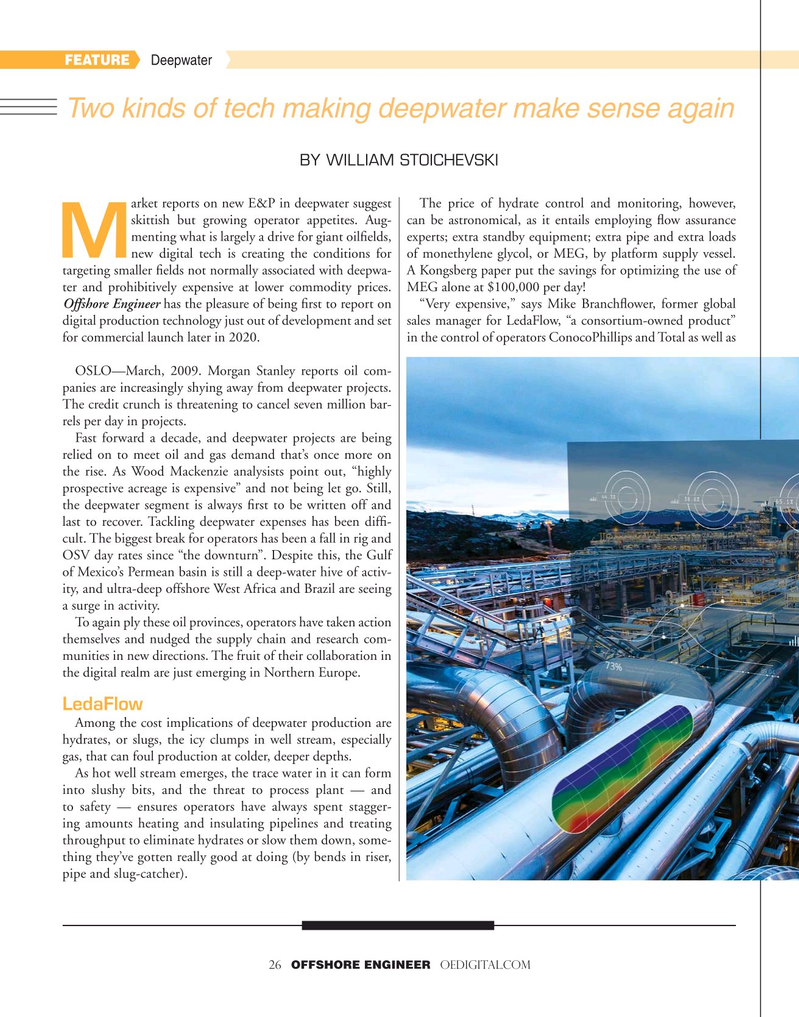
Page 26: of Offshore Engineer Magazine (Mar/Apr 2020)
Offshore Wind Outlook
Read this page in Pdf, Flash or Html5 edition of Mar/Apr 2020 Offshore Engineer Magazine
FEATURE Deepwater
Two kinds of tech making deepwater make sense again
BY WILLIAM STOICHEVSKI arket reports on new E&P in deepwater suggest The price of hydrate control and monitoring, however, skittish but growing operator appetites. Aug- can be astronomical, as it entails employing ?ow assurance menting what is largely a drive for giant oil?elds, experts; extra standby equipment; extra pipe and extra loads
M new digital tech is creating the conditions for of monethylene glycol, or MEG, by platform supply vessel. targeting smaller ?elds not normally associated with deepwa- A Kongsberg paper put the savings for optimizing the use of ter and prohibitively expensive at lower commodity prices. MEG alone at $100,000 per day!
Offshore Engineer has the pleasure of being ?rst to report on “Very expensive,” says Mike Branch?ower, former global digital production technology just out of development and set sales manager for LedaFlow, “a consortium-owned product” for commercial launch later in 2020. in the control of operators ConocoPhillips and Total as well as
OSLO—March, 2009. Morgan Stanley reports oil com- panies are increasingly shying away from deepwater projects.
The credit crunch is threatening to cancel seven million bar- rels per day in projects.
Fast forward a decade, and deepwater projects are being relied on to meet oil and gas demand that’s once more on the rise. As Wood Mackenzie analysists point out, “highly prospective acreage is expensive” and not being let go. Still, the deepwater segment is always ?rst to be written off and last to recover. Tackling deepwater expenses has been dif?- cult. The biggest break for operators has been a fall in rig and
OSV day rates since “the downturn”. Despite this, the Gulf of Mexico’s Permean basin is still a deep-water hive of activ- ity, and ultra-deep offshore West Africa and Brazil are seeing a surge in activity.
To again ply these oil provinces, operators have taken action themselves and nudged the supply chain and research com- munities in new directions. The fruit of their collaboration in the digital realm are just emerging in Northern Europe.
LedaFlow
Among the cost implications of deepwater production are hydrates, or slugs, the icy clumps in well stream, especially gas, that can foul production at colder, deeper depths.
As hot well stream emerges, the trace water in it can form into slushy bits, and the threat to process plant — and to safety — ensures operators have always spent stagger- ing amounts heating and insulating pipelines and treating throughput to eliminate hydrates or slow them down, some- thing they’ve gotten really good at doing (by bends in riser, pipe and slug-catcher). 26 OFFSHORE ENGINEER OEDIGITAL.COM

 25
25

 27
27